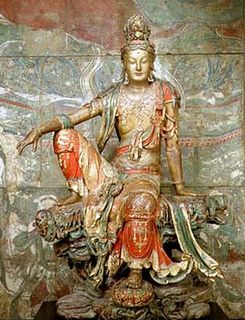Vacation to the Rif Mountains, Part II
The Rif Mountains region is internationally associated with the cultivation of hashish1; having gone to the UCSC2, you'd expect me to know this .. but I didn't .. and that's not the reason I decided to visit Chaouen. 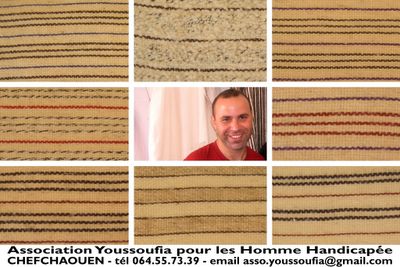 One of the reasons I wanted to visit Chaouen was to visit an artisanal weaving cooperative that came to a recent craft fair in Khemisset: Association Youssoufia pour les Homme Handicapee.
One of the reasons I wanted to visit Chaouen was to visit an artisanal weaving cooperative that came to a recent craft fair in Khemisset: Association Youssoufia pour les Homme Handicapee.
The association consists of about 40 artisans who are primarily weavers; they were invited to participate in acraft fair in my town. I took the opportunity to meet with the association's president (pictured) to learn about their marketing strategies and product development, and how I could help them. This "postcard" shows some of the wool fabrics they weave and sell; some members are also tailors and seamsters, making fine winter jackets and coats. I've already ordered a coat in anticipation of a cold winter.
Chaouen is very tourist-friendly, where guides and shopkeepers are not overly aggressive in dealing with tourists, i.e. they don't grab you by the arm and pull you into their shops.
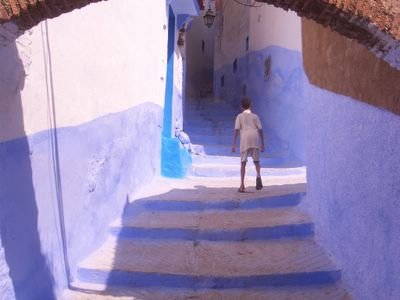
Once a year, the majority of homes in the medina are bathed in a whitewash lime mixture of water and blue paint; the blue is thought to ward off the evil eye. We arrived in town rather late in the day, during high tourist season. Vacationing on a shoe-string budget, we slept on the roof of a pension that first night.
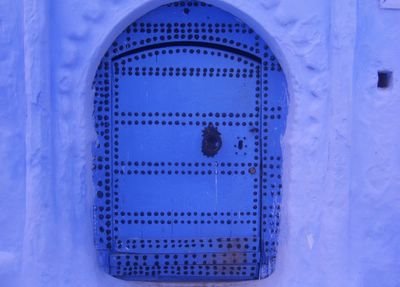
This is a typical blue-painted door of homes in the medina.
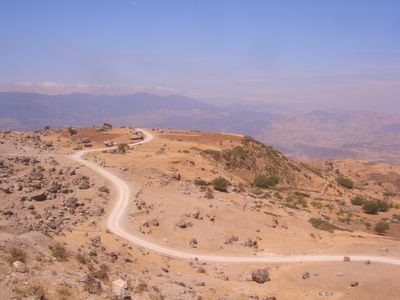
The region around Chaouen is popular with tourists looking for hiking trails and camp grounds. Going on a four-hour hike-loop took us across hashish plantations and slowly up the foothills of the Rif.
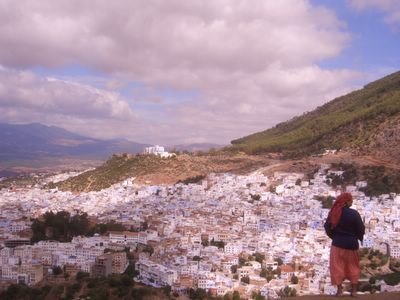
Trekkers hiking just a short distance outside of Chaouen are rewarded with this dramatic townscape; even locals take pride in their town and the fresh air (often with a hint of kif).

One of the attractions in Chaouen is the ancient kasbah (fortress-castle) with its quiet garden and retired prison. The kasbah and the 15th-century Grand Mosque (with its distinctive octagonal minaret) are in the cobbled Plaza Uta el Hamman.
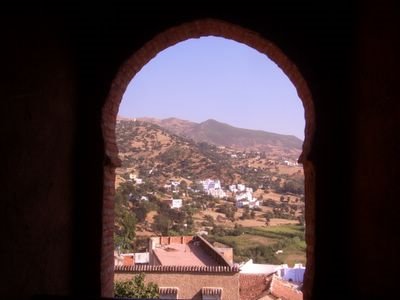
This is a view from the inside of the prison tower of the kasbah.

One of the buildings next to the defunct prison now serves as an art gallery for visiting artists. I forgot to write down the name of the artist, but his works is clearly influenced by Hinduism.
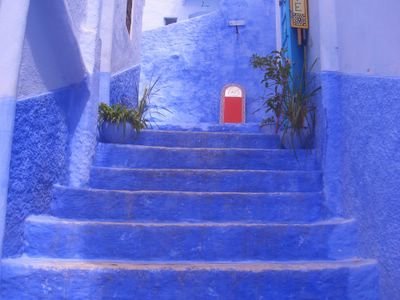
I was already making plans to visit Chaouen even as I took an early morning stroll through the medina.

One of the many cats in the medina saying bye-bye as we headed out towards our next destination: Tetouan and the coastal town of Martil.
1. Hashish is also known as cannabis, marijuana, MJ, kif, etc.
2. University of California at Santa Cruz; however, many UCSC alumni also refer to the higher education institution as Uncle Charlie's Summer Camp for its Redwood forests and idyllic beaches.
 One of the reasons I wanted to visit Chaouen was to visit an artisanal weaving cooperative that came to a recent craft fair in Khemisset: Association Youssoufia pour les Homme Handicapee.
One of the reasons I wanted to visit Chaouen was to visit an artisanal weaving cooperative that came to a recent craft fair in Khemisset: Association Youssoufia pour les Homme Handicapee.The association consists of about 40 artisans who are primarily weavers; they were invited to participate in acraft fair in my town. I took the opportunity to meet with the association's president (pictured) to learn about their marketing strategies and product development, and how I could help them. This "postcard" shows some of the wool fabrics they weave and sell; some members are also tailors and seamsters, making fine winter jackets and coats. I've already ordered a coat in anticipation of a cold winter.
Chaouen is very tourist-friendly, where guides and shopkeepers are not overly aggressive in dealing with tourists, i.e. they don't grab you by the arm and pull you into their shops.

Once a year, the majority of homes in the medina are bathed in a whitewash lime mixture of water and blue paint; the blue is thought to ward off the evil eye. We arrived in town rather late in the day, during high tourist season. Vacationing on a shoe-string budget, we slept on the roof of a pension that first night.

This is a typical blue-painted door of homes in the medina.

The region around Chaouen is popular with tourists looking for hiking trails and camp grounds. Going on a four-hour hike-loop took us across hashish plantations and slowly up the foothills of the Rif.

Trekkers hiking just a short distance outside of Chaouen are rewarded with this dramatic townscape; even locals take pride in their town and the fresh air (often with a hint of kif).

One of the attractions in Chaouen is the ancient kasbah (fortress-castle) with its quiet garden and retired prison. The kasbah and the 15th-century Grand Mosque (with its distinctive octagonal minaret) are in the cobbled Plaza Uta el Hamman.

This is a view from the inside of the prison tower of the kasbah.

One of the buildings next to the defunct prison now serves as an art gallery for visiting artists. I forgot to write down the name of the artist, but his works is clearly influenced by Hinduism.

I was already making plans to visit Chaouen even as I took an early morning stroll through the medina.

One of the many cats in the medina saying bye-bye as we headed out towards our next destination: Tetouan and the coastal town of Martil.
1. Hashish is also known as cannabis, marijuana, MJ, kif, etc.
2. University of California at Santa Cruz; however, many UCSC alumni also refer to the higher education institution as Uncle Charlie's Summer Camp for its Redwood forests and idyllic beaches.
tags: peace corps.africa.morocco
previous 10 posts:
- Vacation to the Rif Mountains, Part I
- Postcards For Everyone
- As Time Goes By
- Letter From Senator Barbara Boxer
- Weekly Fish Fry at the Souk
- In-Service Training
- Time to Hit the Beach!
- Room with a Sunset
- Unexpected Dinner Guest
- Letter from Ministry of Tourism





